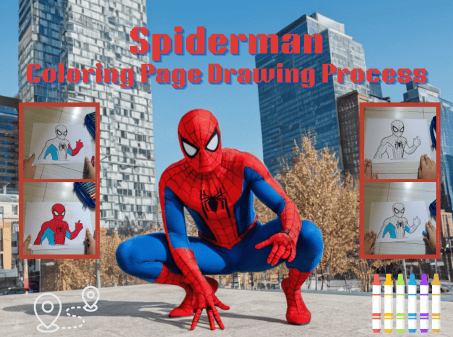Table of Contents
Unlock the secrets of drawing Spiderman like a pro with our detailed tutorial. From simple sketches to vibrant coloring, this guide is packed with tips to help you capture the essence of your favorite web-slinging superhero. Whether you’re a budding artist or a seasoned enthusiast, our step-by-step instructions and free printable Spiderman coloring pages are perfect for bringing Spiderman’s dynamic poses and iconic suit to life. Start your artistic adventure now and impress friends and family with your Spiderman masterpieces! You can download our Spiderman coloring pages for free and as printable.
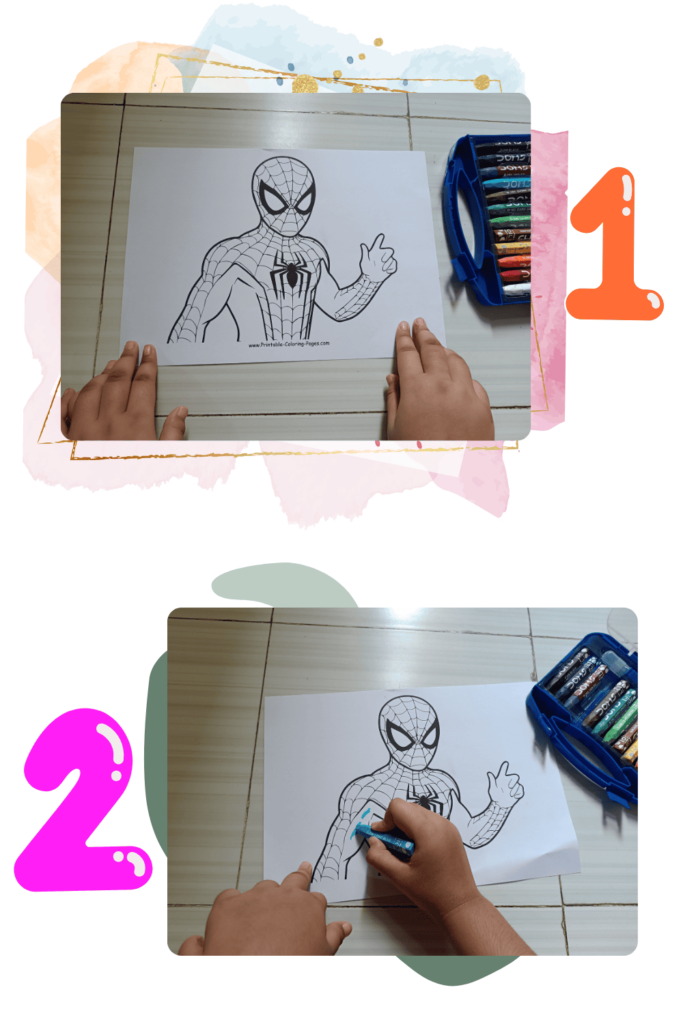
By implementing these SEO strategies, the article will be better positioned to rank in search engine results, attract more targeted traffic, and encourage engagement from Spiderman fans and aspiring artists.
Why did Spiderman Drawing?
Spiderman is more than just a comic character; he’s a symbol of courage and resilience. Drawing Spiderman can inspire these qualities in artists, especially young learners, fostering creativity and confidence. For adults, the intricate details of his costume offer a challenge that can be both meditative and rewarding.
Materials Needed
Before we start, ensure you have the following materials:
- Graphite pencils
- High-quality eraser
- Fine liners or a black marker
- Color pens (preferably alcohol-based for smooth blending)
- Quality drawing paper
- A Spiderman reference image (for accuracy)
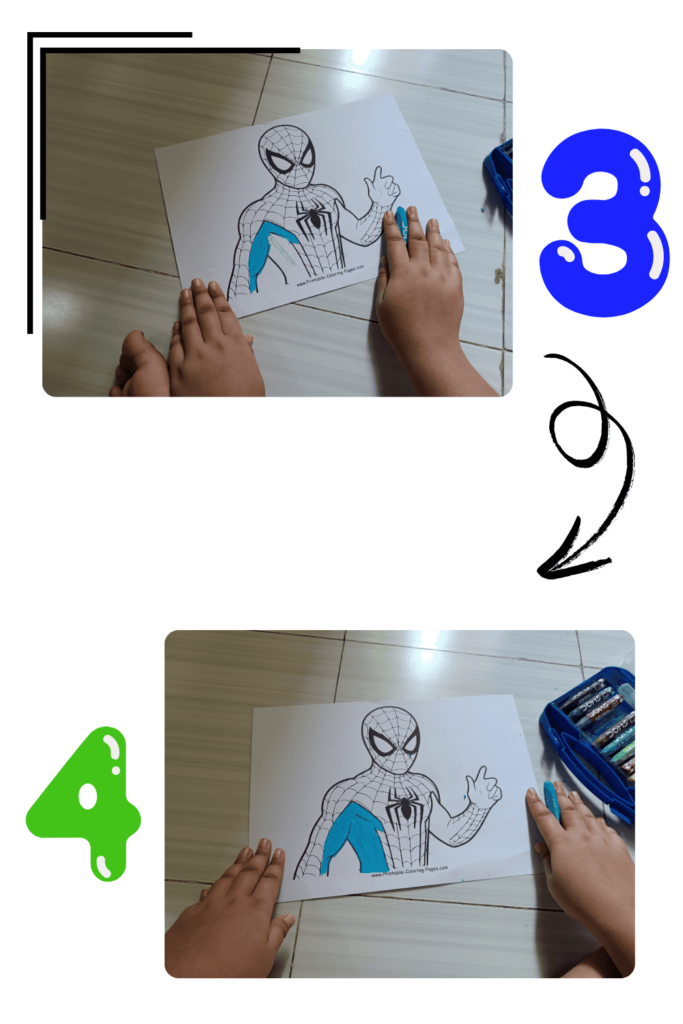
Step-by-Step Guide to Drawing Spiderman
- Outline the Basic Structure: Begin by drawing a skeletal outline of Spiderman in a dynamic pose. Use light strokes to sketch the head, torso, arms, and legs. This will serve as the foundation for your drawing.
- Refine the Silhouette: Once the basic structure is in place, add muscle definition and refine the silhouette. Pay special attention to Spiderman’s athletic build—his muscular arms and legs, which are crucial for his acrobatic stunts.
- Add the Costume Details: Start adding details such as the web pattern on his suit. The web starts at the mask and extends down the body. Don’t forget the spider emblem on his chest. Use a light hand to sketch these details, as they will guide the inking later.
- Ink the Drawing: Using fine liners or a black marker, carefully go over your pencil lines. This step will define the sharp details of Spiderman’s costume and pose. Allow the ink to dry completely, and erase any visible pencil marks.
- Base Coloring: Begin coloring by laying down the base colors of Spiderman’s suit. Use a bright red color pen for the main parts of his suit and a vibrant blue for the pants and sections of his arms. Ensure to leave areas like the eyes, which will usually be white or a very light blue.
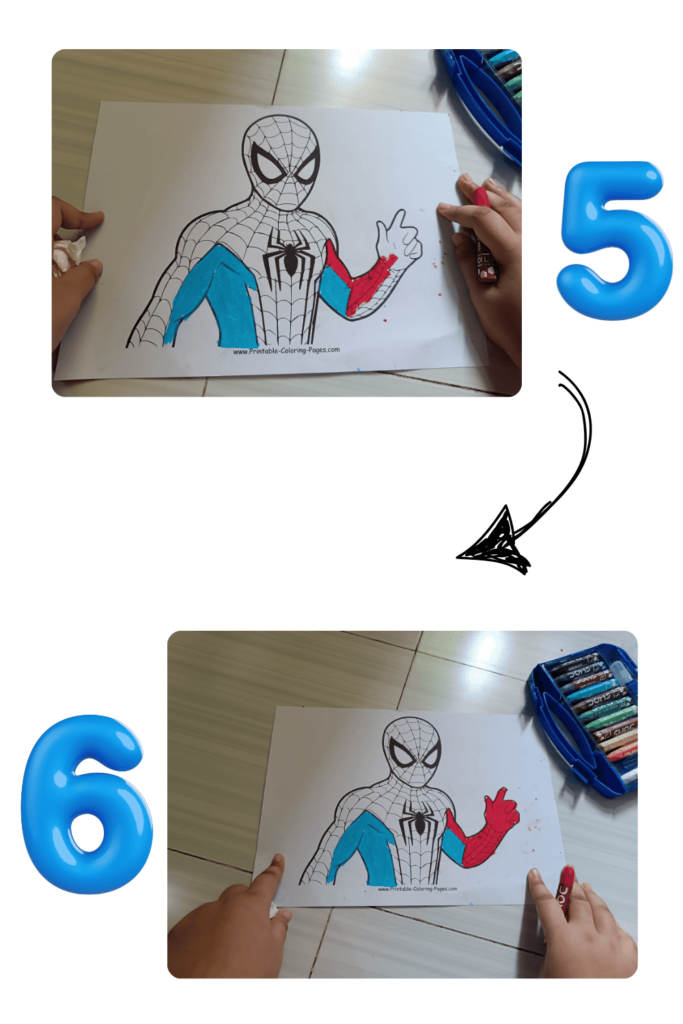
Coloring Techniques with Color Pens
- Layering Colors: Start with lighter shades and gradually add darker tones to create depth. For red areas, lay a base of light red, and add darker shades along the edges and where shadows naturally occur. Use a similar approach for the blue areas.
- Blending: Use a colorless blender pen or lightly overlap the colors to blend them smoothly. This technique is particularly useful for creating gradient effects on Spiderman’s suit and giving it a more three-dimensional look.
- Highlights and Shadows: Add highlights where the light naturally hits the suit, such as the shoulders, knees, and the top of the head. Use a white pen or a light color to add these effects. For shadows, use darker shades of blue and red to deepen the creases of his suit and under his arms, between the legs, and under his chin.
- Background Elements: If you want to include a background, consider drawing a simple cityscape silhouette or a web-slinging scene. Keep the background less vibrant to ensure Spiderman stands out.
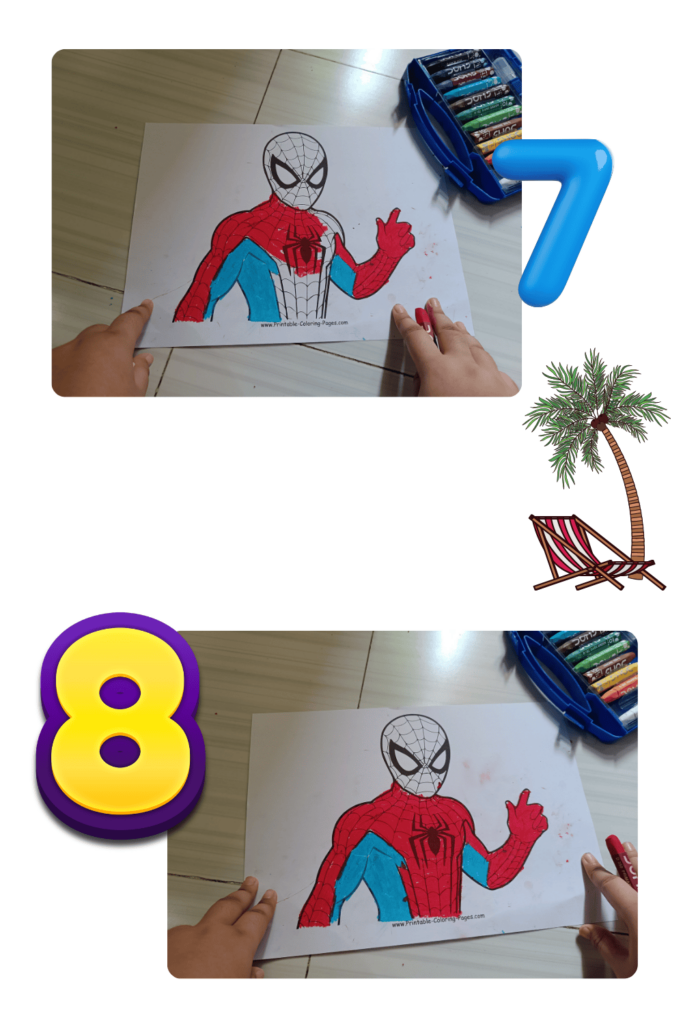
Advanced Tips
For those looking to enhance their drawing, consider experimenting with action scenes that incorporate more dynamic poses or interactions with villains. Additionally, you could explore different lighting scenarios, such as a nighttime scene with contrasting highlights and shadows.
Spiderman coloring techniques
Mastering Spiderman coloring techniques requires a blend of skill and creativity. Start with basic flat colors; use vivid red for his suit and deep blue for accents. As you progress, introduce shading to add depth and dimension to his muscular structure, highlighting areas where light naturally hits—like the shoulders and knees. For a dynamic touch, incorporate webbing details with a fine liner to define the intricate patterns. These techniques will not only enhance the visual appeal of your Spiderman artwork but also bring the character to life with striking realism and vibrancy.
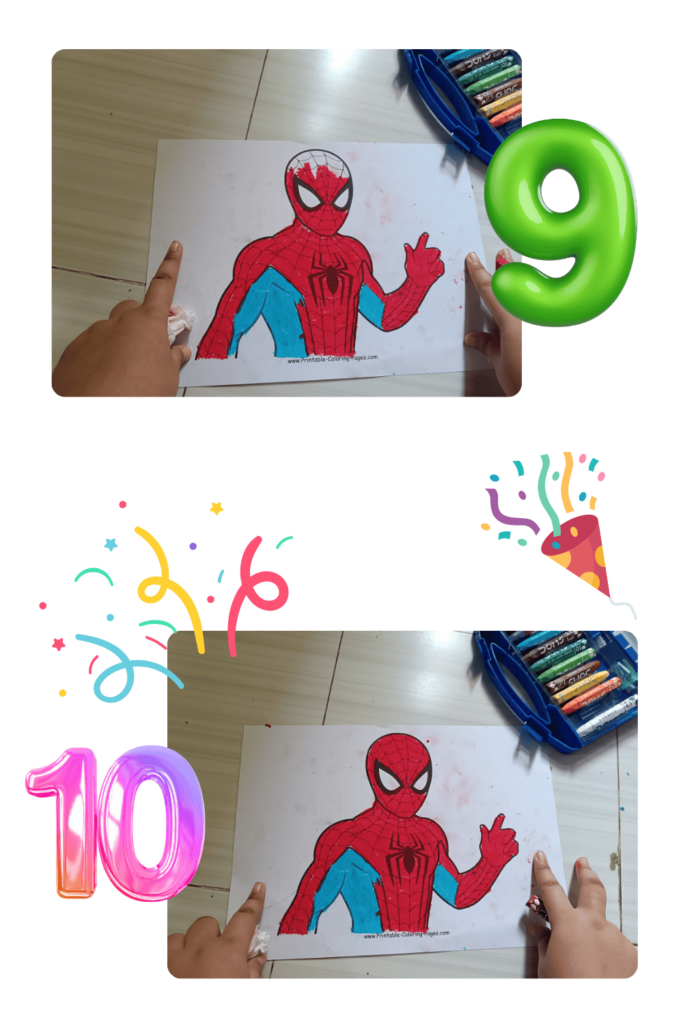
As a parent, you have to know why coloring page.
Cognitive and Emotional Development in Children
Coloring pages are often viewed as mere entertainment for children, but they play a significant role in cognitive and emotional development. Engaging in coloring activities can enhance fine motor skills, stimulate creativity, and promote emotional expression. This article aims to elucidate how coloring pages affect child brain development, providing parents with insights into the benefits of incorporating coloring into their children’s daily routines.
Fine Motor Skills Development
One of the most immediate benefits of coloring is the enhancement of fine motor skills. Fine motor skills are crucial for tasks such as writing, buttoning shirts, and using utensils. Research indicates that coloring activities serve as a foundational step in preparing children for writing by improving their hand-eye coordination and dexterity (Janah, 2023). As children manipulate crayons or markers, they learn to control their movements, which is essential for later writing tasks. A study conducted by Janah highlights that early coloring activities significantly contribute to the development of these skills, allowing children to express their creativity while honing their motor abilities (Janah, 2023).
Moreover, coloring requires children to stay within the lines, which promotes precision and control. This aspect of coloring not only aids in fine motor development but also teaches children about boundaries and spatial awareness. Sisianti’s research supports this notion, demonstrating that through coloring, children learn to navigate the limits of their drawings, thereby enhancing their cognitive understanding of space and boundaries (Sisianti, 2024).
Cognitive Development and Color Recognition
Coloring activities also play a vital role in cognitive development, particularly in color recognition and categorization. The ability to identify and name colors is an essential cognitive skill that contributes to a child’s overall learning and memory capabilities. Istiono’s study emphasizes that recognizing colors stimulates children’s visual senses and enhances their cognitive processing (Istiono, 2022). This cognitive engagement is crucial as it lays the groundwork for more complex learning tasks, including language development and problem-solving skills.
Furthermore, the process of mixing colors during coloring can introduce children to basic concepts of color theory, such as primary and secondary colors. Surwayaningrat and Sumilat’s research indicates that using demonstration methods to teach children about color mixing can significantly enhance their understanding of color relationships, thereby enriching their cognitive experiences (Surwayaningrat & Sumilat, 2021). This understanding not only fosters creativity but also encourages logical thinking as children begin to grasp how different colors interact.
Emotional Expression and Psychological Benefits
Coloring is not just a physical and cognitive activity; it also serves as a powerful medium for emotional expression. The colors children choose can reflect their feelings and moods, providing parents with insights into their emotional states. Research suggests that specific colors can elicit distinct emotional responses, which can be particularly telling in children’s artwork (Babaji et al., 2017; Hotwani & Sharma, 2017). For instance, bright colors may indicate happiness or excitement, while darker shades might suggest sadness or frustration. This aspect of coloring can be an effective tool for parents to understand and support their children’s emotional development.
Additionally, engaging in coloring can serve as a calming activity, helping to reduce anxiety and stress. Studies have shown that children often experience anxiety in various situations, and coloring can provide a therapeutic outlet for these feelings. Babaji et al. found that environments designed with child-friendly colors can create a positive atmosphere, which can alleviate anxiety and foster a sense of safety (Babaji et al., 2018). This therapeutic effect is particularly beneficial in settings where children may feel overwhelmed, such as during medical visits or new experiences.
Creativity and Imagination
Coloring activities significantly enhance children’s creativity and imaginative thinking. When children are given the freedom to choose colors and create their own designs, they engage in a form of self-expression that is crucial for creative development. Aisyah’s research highlights that when children are encouraged to experiment with colors, they not only improve their artistic skills but also expand their imaginative capabilities (Aisyah, 2017). This creative engagement is essential for problem-solving and innovative thinking, skills that are increasingly valued in today’s world.
Moreover, the advent of technology has introduced new dimensions to coloring activities. Digital coloring applications, such as those utilizing augmented reality, can further stimulate children’s creativity by allowing them to interact with their artwork in dynamic ways. Kisno et al. discuss how digital storytelling combined with coloring can enhance children’s engagement and creativity, providing them with a multifaceted learning experience (Wibawa, 2022). This integration of technology into traditional coloring activities can captivate children’s interest and encourage them to explore their creative potential further.
Social Skills and Collaboration
Coloring can also promote social skills and collaboration among children. Group coloring activities encourage teamwork and communication as children share materials, ideas, and techniques. This collaborative aspect of coloring helps children develop important social skills, such as sharing, taking turns, and respecting others’ creative expressions. The social interactions that occur during these activities can foster friendships and improve children’s ability to work in group settings.
Conclusion
Drawing and coloring Spiderman is not just an artistic endeavor but a way to connect with one of the most inspiring superheroes. It provides a creative outlet and a chance to improve one’s drawing and coloring skills. If you are a superhero lover, don’t forget to visit our Superman Coloring Pages. Whether you’re a beginner or an experienced artist, following these steps can help you create a stunning piece of Spiderman artwork.
References:
Aisyah, A. (2017). Permainan warna berpengaruh terhadap kreativitas anak usia dini. Jurnal Obsesi Jurnal Pendidikan Anak Usia Dini, 1(2), 118. https://doi.org/10.31004/obsesi.v1i2.23 Babaji, P., Chauhan, P., Churasia, V., Kaur, T., Singh, S., & Augustine, M. (2018). A cross-sectional evaluation of children preference for dentist attire and syringe type in reduction of dental anxiety. Dental Research Journal, 15(6), 391. https://doi.org/10.4103/1735-3327.245228 Babaji, P., Chauhan, P., Rathod, V., Mhatre, S., Paul, U., & Guram, G. (2017). Evaluation of child preference for dentist attire and usage of camouflage syringe in reduction of anxiety. European Journal of Dentistry, 11(04), 531-536. https://doi.org/10.4103/ejd.ejd_223_17 Hotwani, K. and Sharma, K. (2017). Assessment of the impact of colors on child’s anxiety and treatment preference for local anesthesia injections. Journal of Advanced Oral Research, 8(1-2), 42-46. https://doi.org/10.1177/2229411217729084 Istiono, W. (2022). Bilingual color learning application as alternative color learning for preschool student. International Journal of Interactive Mobile Technologies (Ijim), 16(05), 224-233. https://doi.org/10.3991/ijim.v16i05.28319 Janah, S. (2023). Development of early children’s fine motor ability through coloring activities.. https://doi.org/10.4108/eai.26-11-2022.2339373 Sisianti, D. (2024). Empowering coloring program at preschool pelita, tumbang randang village, timpah sub-district. Salus Publica Journal of Community Service, 1(3), 63-69. https://doi.org/10.58905/saluspublica.v1i3.182 Surwayaningrat, N. and Sumilat, J. (2021). Demonstration method in introduce secondary color learning. Journal of Educational Method and Technology, 1(2). https://doi.org/10.36412/jemtec.v1i2.782 Wibawa, B. (2022). Digital storytelling for early childhood creativity: diffusion of innovation “3-d coloring quiver application based on augmented reality technology in children’s creativity development”. International Journal of Online and Biomedical Engineering (Ijoe), 18(10), 26-42. https://doi.org/10.3991/ijoe.v18i10.32845
